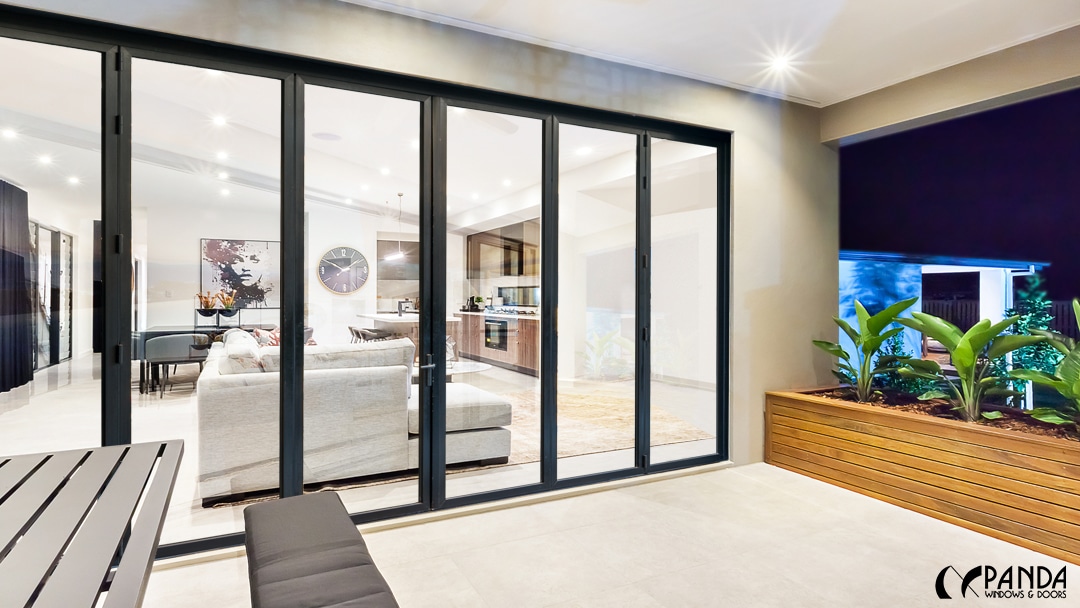Gas-Filled Glass vs Laminated Glass: Which Is Better?
September 29, 2024
Key Takeaways
- Gas-filled glass uses inert gasses like argon, krypton, and xenon to improve thermal performance.
- Laminated glass consists of multiple layers of glass bonded with a tough plastic interlayer for increased safety and sound insulation.
- Each type of glass has unique advantages, with gas-filled being more energy-efficient and laminated offering better security.
- Choosing between gas-filled and laminated glass depends on specific needs such as climate, location, and safety concerns.
- Panda Windows & Doors can help you make the best choice for enhancing home safety and efficiency.
What is Gas-Filled Glass
Gas-filled glass is a type of double or triple-pane glass where the spaces between the glass are filled with an inert gas, usually argon, krypton, or xenon.
These gasses are better at stopping heat from passing through than just air, which helps keep your home warm in the winter and cool in the summer. The inert gasses in the spacer also prevent condensation and frost from creeping in.

Here’s how gas-filled glass works (image courtesy of Cosyhomes Windows).
Advantages of Gas-Filled Glass
- Energy Savings: With better insulation, your heating and cooling systems don’t have to work as hard, which means lower utility bills.
- Comfort: Hot and cold spots in your home? Gas-filled glass helps even out the temperature – so every room is just as cozy or cool as you want it to be.
- Reduced Condensation: Less moisture on your windows means a lower chance of mold or water damage around your sills.

Most importantly, gas-filled glass can also block out some of the sun’s ultraviolet rays, which helps prevent your furniture from fading.
Disadvantages of Gas-Filled Glass
But, gas-filled glass isn’t perfect. Over time, the gas can leak out. If too much escapes, you lose those insulation benefits. And while this glass type is generally more expensive upfront, it’s an investment that pays off in the long run with savings on your energy bills.
|
Founded in 1991, Panda Windows & Doors specializes in state-of-the-art custom glass wall systems for both residential and commercial spaces through Panda Windows & Doors. Operating from our manufacturing facility in Las Vegas, Nevada, we have been at the forefront of innovation for over 30 years. Our extensive product lineup includes over 80 high-end offerings, such as pivot doors, French doors, folding doors, lift & slides, multi-slides, horizontal sliding walls, and operable windows. These systems are available in materials like aluminum, steel, stainless steel, bronze, solid wood, and aluminum-wood clad. We are renowned for our award-winning designs, engineering solutions, and fast lead times, delivering in just 6-10 weeks to customers throughout the U.S. and Caribbean. Trusted by leading architectural firms and glaziers nationwide, we stand as the premier manufacturer of custom luxury windows and doors in the United States. |
What is Laminated Glass
Think of a car windshield – when it cracks, it doesn’t shatter into a million pieces. That’s because it’s made of laminated glass. It’s two sheets of glass that are bonded together with a layer of plastic in between. That plastic layer, usually made from PVB (polyvinyl butyral), keeps the glass from breaking apart, making it a safe choice for your home.

Unlike tempered glass, laminated glass is designed to resist shattering and hold together when broken, reducing the risk of injury from sharp glass shards (image courtesy of Destin Glass).
Advantages of Laminated Glass
- Safety: Because it doesn’t shatter, it’s harder for intruders to break in, and it’s safer if you’ve got kids running around.
- Noise Reduction: That same layer that holds the glass together also muffles sound, so your home stays quieter.
- UV Protection: Laminated glass can block out over 99% of UV radiation, protecting your skin and your furnishings.
Disadvantages of Laminated Glass
One downside to laminated glass is that it can be more costly than regular glass. And while it’s tough, it’s not completely unbreakable. If the glass does break, you’ll need to replace the whole pane, even if it’s just cracked, because of the way it’s made.
Gas-Filled Glass vs Laminated Glass
Energy Efficiency
Gas-filled glass is the clear winner for energy efficiency. The inert gas between the panes acts as an excellent insulator, keeping your home’s temperature steady. This means less strain on your heating and cooling systems, leading to energy savings. In contrast, laminated glass, while providing some insulation, doesn’t match the thermal performance of gas-filled glass.
But remember, efficiency also depends on proper installation. If not sealed correctly, gas-filled windows can lose their insulating properties faster than you’d expect.
Cost Considerations
Gas-filled glass often comes with a higher price tag due to its specialized technology. However, the investment can balance out over time with the energy savings you’ll rack up. On the flip side, laminated glass might have a lower upfront cost, but it won’t contribute as much to your energy bills.
Installation and Maintenance
With gas-filled windows, ensuring a tight seal is crucial for maintaining their insulating properties. Laminated glass needs careful handling to prevent any damage to the layers. As for maintenance, gas-filled windows might require more attention over the years to check for gas leakage, while laminated glass is pretty low-maintenance, needing only regular cleaning to stay clear and strong.
Aesthetic and Practical Considerations
Gas-filled glass is all about subtlety – it looks just like regular glass but works harder to keep your home comfy. Laminated glass offers more options – it can be tinted, colored, or patterned for extra style points and privacy.
Ideal Uses for Each Glass Type
Best Situations for Gas-Filled Glass
Gas-filled glass shines in situations where thermal performance is a must. It’s a smart choice for both new constructions and retrofitting older homes for better energy efficiency.
- Homes in areas with extreme temperatures, where insulation is a top priority.
- Spaces where you want to maximize natural light without the heat loss or gain.
- For those looking to lower their energy consumption and carbon footprint.
Best Situations for Laminated Glass
Laminated glass, with its tough, shatter-resistant properties, is ideal for:
- Ground-level windows and doors where security is a concern.
- Areas exposed to severe weather conditions, providing an added layer of protection.
- Locations near busy streets or airports where noise reduction can make a big difference in your quality of life.
|
Comparison |
Gas-Filled Glass |
Laminated Glass |
|
Energy Efficiency |
– Excellent insulating properties due to the dense gas (argon or krypton) between the panes – Can improve a window’s insulating value by up to 27% compared to regular air-filled windows |
– Provides good insulation, though not as effective as gas-filled glass – The multiple glass layers and plastic interlayer help reduce heat transfer |
|
Cost Considerations |
– More expensive than regular air-filled windows due to the gas filling process – But the energy savings can offset the higher upfront cost over time |
– Also more costly than basic annealed glass – But the safety and security benefits may justify the investment for some applications |
|
Installation and Maintenance |
– Requires professional installation for proper sealing and gas filling – Over time, some gas can slowly leak out, reducing insulating performance |
– The lamination process adds complexity to installation – But the glass itself is relatively low-maintenance once installed – The interlayer can degrade over decades of exposure to UV light and high temperatures |
|
Aesthetic and Practical Considerations |
– Available in a variety of tints and coatings to suit different design preferences – The gas-filled space is not visible |
– Offers more design flexibility, as it can be curved, bent, or patterned – The plastic interlayer is also available in different tints and colors |
|
Best Situations to Use |
– Ideal for locations with predominantly cold weather, as the gas fill provides excellent insulation – Suitable for areas where energy costs are high, as the added insulation can lead to significant savings |
– Best for situations where safety and security are paramount, such as in high-risk areas or for high-security buildings – Suitable for areas with high noise pollution, as the dense glass and interlayer help reduce noise transmission |
Table comparing the characteristics of gas-filled glass and laminated glass.
Making the Right Choice with Panda Windows & Doors
At Panda Windows & Doors, we’re committed to helping you make the right choice for your home’s glass needs. Our team of experts will walk you through the pros and cons of gas-filled and laminated glass, considering your specific situation.
It doesn’t matter if you’re building a new commercial space or upgrading your current home – we’ll make sure that your glass selection enhances your project’s safety, efficiency, and aesthetics. Let us help you create a comfortable and secure environment with the perfect glass choice.
Contact us to learn more about our gas-filled glass and laminated glass for your custom doors and windows.
Frequently Asked Questions (FAQ)
What Drives the Choice Between Gas-Filled and Laminated Glass?
The choice between gas-filled and laminated glass is driven by your specific needs. Consider factors such as climate, location, safety concerns, and energy efficiency goals. If insulation and energy savings are your top priorities, gas-filled glass might be the best option. However, if you’re more concerned with safety, noise reduction, and protection against break-ins or severe weather, laminated glass could be the way to go.
For example, a homeowner in a cold climate with high heating bills would benefit from the thermal performance of gas-filled glass, while a family living near a busy street might prioritize the soundproofing qualities of laminated glass.
Are Both Types of Glass Safe for Homes with Kids?
Yes, both gas-filled and laminated glass are safe options for homes with children. Laminated glass is particularly beneficial because it holds together when broken, reducing the risk of injury from sharp shards.
How Do Climate and Location Affect Glass Choice?
Climate and location play a significant role in your glass choice. Homes in areas with extreme temperature fluctuations will benefit from the superior insulation properties of gas-filled glass. On the other hand, homes in locations prone to severe weather events, like hurricanes or tornadoes, or in high-crime areas may find the added security and durability of laminated glass or even impact-resistant glass to be more advantageous.
Can Gas-Filled and Laminated Glass Be Used Together?
It is possible to combine the benefits of both gas-filled and laminated glass in a single window unit. This hybrid approach can offer superior energy efficiency, safety, and noise reduction. However, it’s essential to consult with professionals like those at Panda Windows & Doors to determine the feasibility and cost-effectiveness of this option for your specific situation.
What Is the Lifespan of Each Glass Type?
The lifespan of each glass type can vary based on factors such as quality of materials, installation, and maintenance.
According to the National Glass Association, gas-filled glass windows can last up to 20 years or more, especially if they retain at least 80% of their gas fill. Laminated glass also has a long lifespan and will continue to provide safety and noise reduction benefits as long as the interlayer remains intact. Regular inspections and maintenance can help extend the life of both types of glass.

Guardian Glass vs Vitrum Glass Group | Prices & Reviews for Window Glass
Compare prices and reviews of Guardian Glass and Vitrum Glass Group to find the best window glass option for your building or renovation project.

Guardian Glass vs AGC Glass | Prices & Reviews for Window Glass
Compare the window glass products, prices, and reviews for Guardian Glass and AGC Glass.

Custom Luxury Glass Curved Radius Windows | Features & Costs
Examine the features and costs of custom luxury glass curved radius windows.











